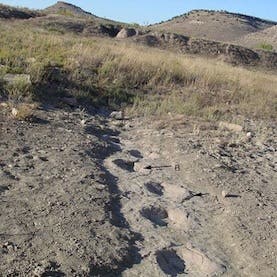Crossing the riverbed of Carrizo Creek in Oklahoma, a series of tracks made by a two-legged dinosaur have been preserved in time for 150 million years. The tracks reveal a most clumsy scene, as the dinosaur in question slipped for a second before going back to his beaten path.

Image: Seth Hammond
When first analyzedin the 1980s, paleontologists described some 47 tracks, but due to erosion, only 14 are visible today. Nevertheless, they still capture a most interesting moment as two of the tracks show signs of the dinosaur stumbling. One has a ridge of mud pushed out and up along its side. The other one is strangely deep — about 0.6 inches (1.6 centimeters) deeper than any of the other tracks.
“What we finally decided is, what must have happened is that the dinosaur slipped as it was walking across this really slippery mudflat, and then that’s where it caught itself,” said researcher J. Seth Hammond, a graduate student in geosciences at Fort Hays State University in Hays, Kan. of the second, deep track.
“In a way, what’s interesting is the everyday trivia,” Hammond said. “He’s just walking across a mudflat and slips like anyone else might.”
The species of the dinosaur is unknown, but paleontologists are fairly certain it belonged to a class of dinosaurs called Therapods, which also includes famous two-legged predators like T. rex and Deinonychus.






